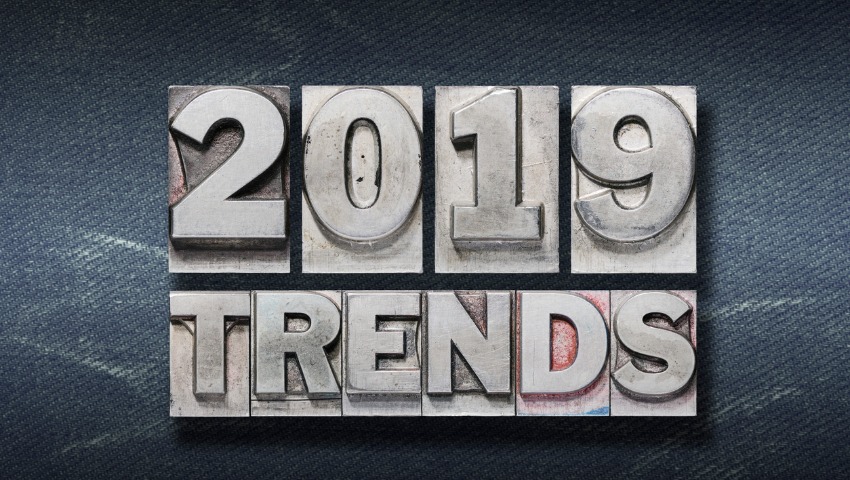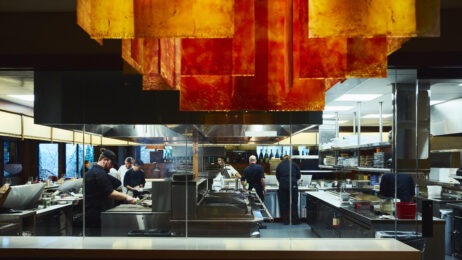As we begin anew, here’s where to start…
My trusty Outlook calendar is telling me it’s time to count down the top hospitality trends of this almost-past, whirlwind of a year. After another 365 days of fresh ideas, hundreds of thousands of steps on expo floors and too many app updates, we distilled it all into the most notable things we saw in the world’s ballrooms this year—and added suggestions for how to make the most of these trends at your next meeting in the new year.
Give us a shout out at #SmartMeetings if you agree—or have spotted something that should be added.
See 25 Pivotal Hospitality Trends for 2018 here.
25. Photobombing
Insta-worthy spots became de rigueur this year, so staging a picture-worthy set at an event is now as much a requirement as a hosted bar.
Now What? The trick is to disrupt the photo op and make it surprising by incorporating light painting, stop action or themed costuming in a way that will compel people to post and tag.
24. Bleisure Everywhere
While the term is now officially a decade old, the practice of tacking on vacation days to business trips has grown at an estimated 7 percent a year, thanks to those trendsetting millennials.
Now What? Today, conference-goers are looking to blend conferences and pleasure by asking that local experiences be included in the agenda during the event. Give them what they want. Schedule a tour of a museum or “unschedule” an evening so attendees can discover the destination for themselves.
23. Increased Anti-Trafficking
Ending Child Slavery at the Source (ECPAT-USA) announced that while more than 70 percent of companies have anti-human trafficking policies in place—including training and contract language addressing the issue—more can still be done.
Now What? Learn the signs and look for suppliers who have signed the code.
22. Sober Curious
In a post-#metoo world, attendees want alternatives to alcoholic beverages beyond water and a Roy Rogers. Some are abstaining for health or religious reasons, others because they need clear focus in the morning.
Now What? Give them something that is just as fun as a signature cocktail—without the downside. That could be a cocktail made with fermented kombucha or a themed alcohol-free beverage. Make sure the one ingredient not missing is joy.
21. Story-Living
The smart folks over at George P. Johnson Experience Marketing have identified an evolution of storytelling in which attendees co-create the experience. Staging as messaging coupled with sensorial immersion make participants feel seen and understood.
Now What? Use technology such as AI to create “depersonalized personalization”—in short, put to work what you already know about attendees from their registration profile.
20. Redefining Gaming
Meeting in stadiums has long been a trick for adding that spirited homefield advantage to an event. But giving attendees the thrill of meeting in arenas of fun and sport is expanding.
Now What? The definition of sport can include games of chance, video egaming and board game tournaments. All these games have spawned development of new, modern venues that cater nicely to groups of all sizes. Get in on the action by considering a location outside the ballroom.
19. Unconference for Good
From Haute Dokimazo’s spontaneous think tanks to Jamie Murdock’s event hackathons, meeting professionals are finding new ways to help attendees crowdsource solutions to their biggest problems. When a conference is so unstructured that attendees don’t even know where they are going until they get on the plane (as was the case with Haute’s Secret Family Reunion to Tuscany), the creative process opens up in ways a traditional conference can’t.
Now What? Try asking your attendees what they would like addressed at your next conference and what they have to contribute. You might be surprised.
18. Economic VEx
What do you get when you marry experiences with new technology? IBTM World Trends Watch Report says the offspring will be the Virtual Experience Economy, which will “change the meetings and events landscape and what new opportunities it presents.”
Now What? Mixed reality could be in your future. Just make sure you are adopting the technology to enhance the goals of the conference, not just to say you did.
17. Beyond Busing
Getting attendees from point A to point B is getting way cooler. Construction started this year on tunneling for a two-loop tunnel in Las Vegas that will shuttle high-occupancy, autonomous electric vehicles at speeds of up to 45 mph. The futuristic journey starts at Las Vegas Convention Center and could eventually extend to McCarran International Airport (LAS) and Los Angeles. Above ground, driverless shuttles are being tested at Austin-Bergstrom International Airport (AUS) and in Columbus, Ohio; Pittsburgh and University of Michigan.
Now What? Look for ways to leverage existing public transportation and hotel shuttles to streamline logistics and shrink greenhouse footprints.
16. Welcome All Y’all
Inclusiveness is the new normal. Whether it is accommodating special diets, physical aids such as wheelchairs and hearing aids or those with sensory processing challenges, planners are being urged to consider the needs of more than the cohort sometimes referred to as TABs (temporarily able-bodied).
Now What? Often the difference between feeling welcomed and singled out is training. Make sure everyone on your team and your suppliers are well-versed in the fine art of meeting the needs of all who come through the door.
15. United Independents
While 2018 was the year major hotel brands announced they would cut commissions from 10 percent to 7 percent, this was the year the 30 percent reduction hit the bottom line for third-party planners. Alliance of Independent Meeting Professionals (Originally Meeting Planners Unite) formed in the wake of those decisions and is positioning itself to support planners in many ways, including health care, education and philanthropy.
Now What? Check out the group’s website and stay up to date on its advocacy work. Oh, and when you get a chance, hug a planner.
14. Holistic Health
Keeping attendees and yourself healthy goes beyond including a bowl of apples and a map of local jogging routes. A new study by CWT found that a growing percentage of business travelers actually eat healthier than before while on the road and stick to their exercise routine. More planners are also including mental health in their agenda in the form of meditation sessions.
Now What? Attendees don’t necessarily want to be required to eat well and exercise, but they appreciate being given healthy options, including enough time for rest. Keeping that in mind when picking a property and designing the agenda can go a long way to keeping everyone in top shape.
13. High-Def Audiovisual
Move over boom box and disco ball. New tech is making everything clearer. Messaging is now accessible to everyone via streaming services, so attendees inside and outside the room can control from their phone what they hear and in what language. LED screens have made high-impact presentations possible and transforming a room easy.
Now What? Partner with your AV company to get the biggest emotional bang for your meeting dollar.
12. Zero Waste
Meetings have gone beyond recycling to encompass reducing the amount of packaging and shipping, increasing food donation and composting, and eliminating single-use plastics from dining and the guest rooms. Straws, sporks and plastic water bottles are now endangered species. Say goodbye as well to little bottles of shampoo and conditioner.
Now What? Gifting branded, refillable water jugs is the rage, and communicating your efforts to shrink your footprint helps turn attendees into active conservationists.
11. Futureproofing
Hotels have come a long way in the 100 years since Conrad Hilton opened his first property in Cisco, Texas, and attendees now expect all the comforts of home—and then some—when they open that guest room door with their smart phones. Cristina Villalon, principal interior designer at Alvarez-Diaz & Villalon Architecture & Interior Design, thinks guests are looking for more personalized spaces with a connection to the outdoors (think waterfalls, living walls and lots of plants), augmented by plenty of technology. Marriott International is paving the way for what it calls “mind travel” by creating social and private spaces where guests can reach their full creative potential.
Now What? Look for hotel partners that have invested in modular design to maximize flexibility and plenty of connections, or as David Lambert, director of sales and marketing for the brand-new Grand Hyatt at SFO, says, places that are “lit up.”
10. AltHealthy
A wedge of iceberg lettuce slathered in blue cheese dressing no longer qualifies as a balanced diet (if it ever did). Kimpton Hotels & Restaurants 2020 Culinary & Cocktail Trends report points to the healthful yearnings of alternative milk (oat and hemp), fermented foods (tempeh, infused vinegars and probiotics) and plant-based meat-alternative everything.
Now What? Work with the culinary team at your host hotel to craft menus that offer something for the gluten-free, vegan and Keto guests in your midst. Then label it so people know what they are putting into their bodies.
9. Bigness Rules
Mergers continued to consolidate the industry as companies joined forces to leverage synergies—while narrowing choices for the rest of us. AEG Facilities and SMG formed ASM Global, the largest facilities management and venues services company. Eldorado Resorts bought Caesars for $17.3 billion to make it one of the largest gambling and entertainment ventures in the United States. MGM Resorts International sold Bellagio to a real estate investment trust. STR found that due to mergers and funding issues, fewer independent hotel properties are available.
Now What? The consolidations could be good news for those who want to manage multiple contracts across properties, but finding that one-of-a-kind partner may require more hunting.
8. A Long Road
According to a study by WiH2020 (women in hospitality), progress toward narrowing a lingering pay gap has been slow—a 0.4 percent annual decrease in the pay gap between sexes across hospitality, travel and leisure. Average salaries for men are still 7.6 percent higher than for women.
Now What? Join groups such as AWE in a quest to build a community that inspires women and helps everyone accelerate careers.
7. Uber-Data Privacy
For those who still haven’t accounted for the data-sharing requirements in Europe’s 2018 General Data Protection Regulation (GDPR) laws, California brought the issue home with California Consumer Privacy Act (CCPA), which goes into effect January 1. It requires disclosure of privacy practices and an easy way for attendees to opt out of any sharing.
Now What? Being 100 percent transparent about how you protect and use your lists is a best practice no matter how many new acronyms might be enacted by legislatures around the world. Treat your attendees and their information as you would like to be treated.
6. Flight Shaming
In the wake of Greta Thunberg’s epic trek across the ocean to speak out on behalf of future inhabitants of the planet, some have pointed to airline travel as an eco-unfriendly waste of resources. Others are pushing for greener venues.
Now What? Event professionals are responding by pointing to offsets in the form of CSR activities and the massive return on investment meetings have. Meeting f2f helps to cure diseases, advance technology and get business done.
5. Journeymapping
Conference attendees embark on an experiential journey the moment they hear about an event. Every piece of communication, interaction during the registration process, hotel stay, speaker interaction and follow-up email sets or reinforces an expectation. Smart event professionals leave nothing to chance and use technology to remove friction wherever possible. From data mapping to facial recognition and live polling to determine audience engagement in real-time, guests expect bespoke messaging.
Now What? Start by getting to know your attendees and aligning this info with your company’s goals. Ask questions and make priority decisions based on your findings. That kind of strategic thinking is what elevates meeting professionals’ careers.
4. Safety First
The age of the live shooter has put everyone on edge, including meeting professionals who are tasked with keeping attendees safe wherever they are. One veteran planner started a Coalition to Prevent Gun Violence at Events. More venues require metal detectors and security guards for access control. But threats come in many forms—and often when you least expect them.
Now What? The planner’s secret weapon when it comes to natural and man-made emergencies is communication. Work with partners to create a plan, share essential details with attendees and stay calm when the worst happens.
3. Rideshare Segregation
It was the best of years for travelers looking for a ride to the terminal. It was the worst of years for finding that ride to the hotel, as airports across the country acted to ease congestion near baggage claim by forcing Uber and Lyft pick-ups to isolated areas. In Los Angeles, ride shares are now relegated to an area called LAX-It that is a shuttle bus ride away, even if it does offer food trucks and toilets.
Now What? Call (or Google) ahead to see what policies are at your destination and communicate that to your attendees. Or, when at JFK, check out the new Uber Copter taxi that makes the trip to Lower Manhattan in eight New York minutes.
2. A Social Manifesto
CSR has been making its way onto more agendas as backpack stuffing and bike assembling brings groups and local communities together.
Now What? The incentive industry stepped up this year with a pledge to embrace social responsibility as part of SITE’s The Bangkok Manifesto. As communities face more challenges related to increasingly scarce natural resources, shifting weather patterns, overtourism and the negative impacts of a disposable culture, travelers around the world have greater responsibility than ever to consider solutions. “Travel can and should be a force for good,” said Denise Naguib, vice president of global sustainability and supplier diversity for Marriott International.
1. $2.53 Trillion Mission
Meetings Mean Business doubled down on the job of letting the world—including elected officials—know how much impact events have on economies, scientific developments and the welfare of everyone involved.
Now What? Get ready to celebrate the good work you do every day on Global Meetings Industry Day Tuesday, April 14, 2020.




